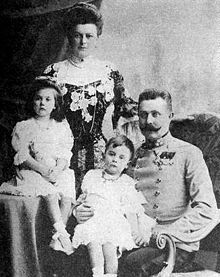This is an old revision of this page, as edited by 70.59.56.224 (talk) at 06:22, 14 December 2006 (reverting. Vandalism). The present address (URL) is a permanent link to this revision, which may differ significantly from the current revision.
Revision as of 06:22, 14 December 2006 by 70.59.56.224 (talk) (reverting. Vandalism)(diff) ← Previous revision | Latest revision (diff) | Newer revision → (diff) "Franz Ferdinand" redirects here. For other uses, see Franz Ferdinand (disambiguation).
Franz Ferdinand, Archduke of Austria-Este (December 18, 1863 – June 28, 1914) was an Archduke of Austria, Prince Imperial of Austria, Prince Royal of Hungary and Bohemia, and from 1896 until his death, heir presumptive to the Austro-Hungarian throne. His assassination in Sarajevo precipitated the Austrian declaration of war which triggered World War I.
==Birth and early life

Franz Ferdinand was born in Graz, Austria, the eldest son of Archduke Karl Ludwig of Austria (younger brother of Emperor Franz Josef) and of his second wife, Princess Maria Annunciata of the Two Sicilies. When he was only twelve years old, his cousin Duke Francis V of Modena, died, naming Franz Ferdinand his heir on condition that he add the name Este to his own. Franz Ferdinand thus became one of the wealthiest men in Austria.
When he was born, there was no reason to think that Franz Ferdinand would ever be heir to the Austro-Hungarian throne. He was given the normal strict education of an archduke with an emphasis on history and moral character. From 1876 to 1885 his tutor was the historian Onno Klopp. In 1883 Franz Ferdinand entered the army with the rank of third lieutenant.
As a young man, Franz Ferdinand developed two great passions: hunting and travel. It is estimated that he shot more than 5,000 deer in his lifetime. In 1883, he visited Italy for the first time in order to see the properties left to him by Duke Francis V of Modena. In 1885, he visited Egypt, Palestine, Syria, and Turkey. In 1889, he visited Germany.
In 1889, Franz Ferdinand's life changed dramatically. His cousin Crown Prince Rudolf committed suicide at his hunting lodge in Mayerling, leaving Franz Ferdinand's father, Archduke Karl Ludwig, as first in line to the throne. Henceforth, Franz Ferdinand was groomed to succeed.
Marriage and family
| Monarchical styles of Franz Ferdinand of Austria-Este | |
|---|---|
 | |
| Reference style | His Imperial and Royal Highness |
| Spoken style | Your Imperial and Royal Highness |
| Alternative style | Sir |
In 1895 Franz Ferdinand met Countess Sophie Chotek at a ball in Prague. To be an eligible marriage partner for a member of the House of Habsburg, one must be a member of one of the reigning or formerly reigning dynasties of Europe. The Choteks were not one of these families, although they did include among their ancestors, in the female line, princes of Baden, Hohenzollern-Hechingen, and Liechtenstein.
Sophie was a lady-in-waiting to Archduchess Isabella, wife of Archduke Friedrich, Duke of Teschen. Franz Ferdinand began to visit Archduke Friedrich's villa in Bratislava (formerly Pressburg). Sophie wrote to Franz Ferdinand during his convalescence from tuberculosis when he went to the island of Lošinj in the Adriatic. They kept their relationship a secret for more than two years.
Archduchess Isabella assumed that Franz Ferdinand was enamored with one of her daughters. In 1898, however, he left his watch lying on a tennis court at her home. She opened the watch, expecting to find there a photograph of one of her daughters; instead, she found a photograph of Sophie. Sophie was immediately dismissed from her position.
Franz Ferdinand refused to consider marrying anyone else. Pope Leo XIII, Tsar Nicholas II of Russia, and the German Emperor Wilhelm II all made representations on Franz Ferdinand's behalf to the Emperor Franz Joseph of Austria, arguing that the disagreement between Franz Joseph and Franz Ferdinand was undermining the stability of the monarchy.
Finally, in 1899, the Emperor Franz Joseph agreed to permit Franz Ferdinand to marry Sophie, on condition that the marriage would be morganatic and that their descendants would not have succession rights to the throne. Sophie would not share her husband's rank, title, precedence, or privileges; as such, she would not normally appear in public beside him.
The wedding took place on July 1, 1900, at Reichstadt (now Zákupy) in Bohemia; Franz Joseph did not attend the affair, nor did any archduke including Franz Ferdinand's brothers. The only members of the imperial family who were present were Franz Ferdinand's stepmother, Maria Theresia, and her two daughters. Upon the marriage, Sophie was given the title Princess of Hohenberg (Fürstin von Hohenberg) with the style Her Serene Highness (Ihre Durchlaucht). In 1909, she was given the more senior title Duchess of Hohenberg (Herzogin von Hohenberg) with the style Her Highness (Ihre Hoheit). This raised her status considerably, but she still took precedence at court after all the archduchesses. Whenever a function required the couple to gather with the other members of royalty, Sophie was forced to stand far down the line of importance, separated from her husband.
Franz Ferdinand's children were:
- Princess Sophie von Hohenberg (1901-1990), married Count Friedrich von Nostitz-Rieneck (1891-1973)
- Maximilian, Duke of Hohenberg (1908-1962), married Countess Elisabeth von Waldburg zu Wolfegg und Waldsee (1904-1993)
- Prince Ernst von Hohenberg (1904-1954), married Marie-Therese Wood (1910-1985)
- A stillborn son (1908)
Assassination

On June 28, 1914, at approximately 11:00 am, Franz Ferdinand and his wife were killed in Sarajevo, the capital of the Austro-Hungarian province of Bosnia and Herzegovina, by Gavrilo Princip, a member of Young Bosnia and one of several assassins organized by The Black Hand (Crna Ruka). The event, known as the Assassination in Sarajevo, was one cause of World War I.
Franz Ferdinand is interred with his wife Sophie in Artstetten Castle, Austria.
See also
| Preceded byFrancis V | Archduke of Austria-Este 1875-1914 |
Succeeded byArchduke Charles, later Emperor |